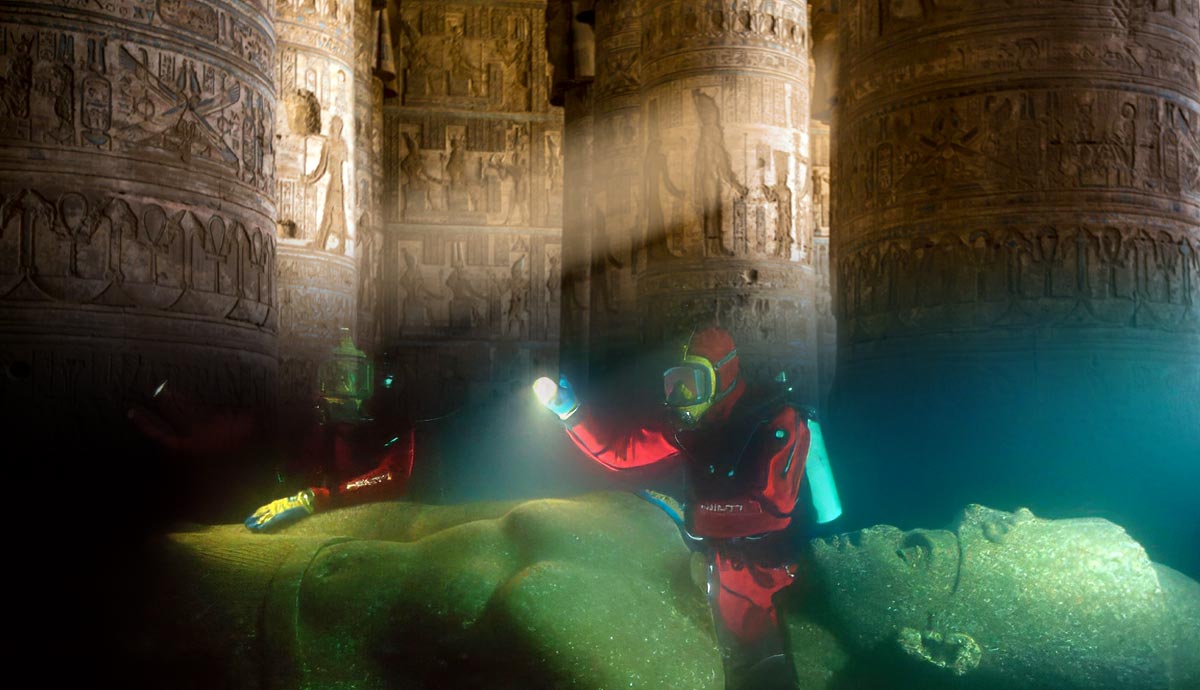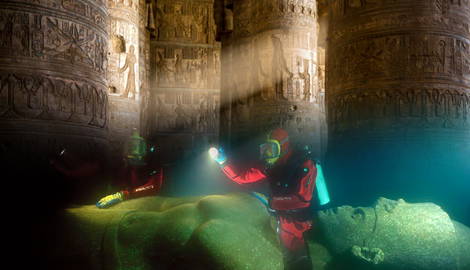
Egypt is home to one of the most ancient civilizations on Earth. Occupied continuously since the 4th millennium BCE, cities have risen and fallen, and even once powerful political, religious, and trading centers have been lost to time. But as archaeologists explore Egyptian sands and seabeds, they are rediscovering lost cities and revealing new secrets about the ancient Egyptian world.
Learn some of the secrets of the recently rediscovered lost Egyptian cities of Aten, Amarna, Heracleion, Tanis, and Abydos.
1. The Dazzling City of Aten

Known as the “lost golden city,” this former capital was named for the Egyptian sun god Aten. Over 3,000 years old, this city is considered to be one of the biggest archaeological discoveries since the famous tomb of Tutankhamun. As with many significant archaeological finds, Aten was discovered by accident while researchers were looking for a mortuary temple for the famous boy-king. Upon finding the lost city, excavation began in September 2020 near Luxor.
Located near the ancient capital of Thebes, the city dates from the 18th dynasty and the reign of the pharaoh Amenhotep III, as evidenced by inscribed vessels and bricks stamped with the seal of the pharaoh. As a pharaoh of the New Kingdom, Amenhotep III ruled over a time of prosperity and power. Aten was a center for administration and industrial activity during what was considered the golden age of ancient Egypt.
The excavated neighborhoods in Aten show evidence of how life was when the empire was at its wealthiest. The city itself is remarkably well preserved, with complete walls and homes full of relics and tools used in everyday Egyptian life. Archaeologists have also uncovered bakeries, tools used for metalworking and glass production, and an administrative district.
What Happened to Aten?

Amenhotep III’s son Amenhotep IV, better known as Akhenaten, made many changes to Egyptian politics and religion. Known as the rebel or heretic king, Akhenaten restructured the Egyptian pantheon in favor of one deity – the sun god Aten. Akhenaten then abandoned the traditional royal seat at Thebes and the administrative complex in Aten in favor of the newly constructed city of Amarna.
2. Akhenaten’s City of Amarna

Located about 400 kilometers north of Luxor on the east bank of the Nile, Armana was built by Akhenaten around 1348 BCE. Amarna was not lost in the physical sense, as Egyptians continued to live in the area for centuries. However, the true origins of the ancient capital were lost because Akhenaten’s successors carefully removed evidence of his reign from recorded history.
In the late 18th century, scientific interest in the extensive ruins increased and archaeologists were drawn to the site. It was mapped by researchers from all over the world, and locals found amazing artifacts such as the Amarna Letters. Written on clay tablets, these letters are an example of the diplomatic correspondence exchanged between Egypt and neighboring territories during the New Kingdom.
Another significant discovery from Amarna is the famous bust of Queen Nefertiti, wife of Akhenaten. This find is very important because her likeness and story were scrubbed from the record along with that of her controversial husband.
What Happened to Amarna?
The city of Amarna was never really lost, but the history of its founder and details of Akhenaten’s reign were essentially wiped from the historical record by his successors. After Akhenaten’s death, Thebes was reestablished as the capital, with all administrative operations and other court attachments relocating accordingly.
Researchers have discovered evidence that Amarna was occupied for at least a full generation after Akhenaten’s reign. Eventually the city was fully abandoned, and villages were established closer to the Nile and on the opposite side of the river.
3. The Underwater City of Heracleion

Once a center of wealth and culture, the ancient Egyptian city of Heracleion lay submerged at the mouth of the Nile Delta for around 1,500 years. Dating back to the 7th century BCE, this port city thrived until it sank into the sea during the 8th century CE. It is thought to have been the largest port on the Mediterranean until Alexandria was founded in 331 BCE.
The city was settled by Egyptian and Greek merchants and artisans, as evidenced by the wonderful variety of artifacts recovered from the sunken ruins. A Greek sanctuary devoted to Aphrodite was also discovered in Heracleion, full of ceramic and bronze artifacts. Greek weapons were also discovered, thought to have belonged to mercenaries charged with defending the Canopic branch of the Nile.
The ruins of Heracleion are about seven kilometers off the modern-day coast of Egypt, under approximately ten meters of water. Temples and the ruins of other buildings were discovered along with massive statues and luxury items such as jewelry and imported Greek ceramics. A tumulus was also discovered, which is a traditional Greek funerary area.
Archaeologists realized the full scale of this once bustling port city when they discovered walls and canals that transected Heracleion. The city was organized around a central temple, with neighborhoods connected by canals. Around 70 shipwrecks and over 700 ancient boat anchors have been found among the canals.
What Happened to Heracleion?

Over time, the area experienced earthquakes and rising sea levels, which triggered flooding of the land at the mouth of the Nile. In turn, this flooding caused the soil underneath Heracleion to liquify. When the ground became unstable, the heavy stone structures of the city sank into the Mediterranean.
Little information about the ancient port city can be found in surviving historical records, so the scientific community did not know the exact location of Heracleion until the year 2000.
4. The Wealthy Trading Center of Tanis

Made famous by Indiana Jones and the Raiders of the Lost Ark, the lost city of Tanis has yielded a tremendous amount of information and dazzling artifacts. However, much of the cinematic depiction of the city is fiction – no Ark of the Covenant or Nazis were involved in the discovery of this lost city.
Located in the northeast Nile River Delta, the ancient city of Tanis was a wealthy center of trade that came to power centuries before Alexandria was founded. During ancient Egypt’s 21st and 22nd dynasties, Tanis also served as the royal seat for lower Egypt.
Archaeologists began to excavate Tanis in the 19th century, and in 1939 a spectacular royal tomb complex was discovered. This remarkable find included intact burial chambers that were undisturbed for nearly 3,000 years. Temples, residential complexes, and a wealth of artifacts were found during subsequent excavations. Some of the most remarkable artifacts were recovered from the tombs, including elaborate sarcophagi, golden masks, jewelry, and luxurious ceramics. Another notable discovery was the burial chamber of King Sheshonq II, whose name and story were lost until archaeologists found his tomb.
What Happened to Tanis?
Tanis rose during a time when political power was divided. Over time, power became consolidated, and the capital of Lower Egypt was eventually abandoned in favor of Memphis. The structures of the once bustling and wealthy city were obscured by sand and silt as the Nile River eventually shifted.
5. The Predynastic City of Abydos

Abydos is probably best known as home to the iconic temple of Seti I. Located in Upper Egypt, the city has long been a sacred site. It served as a necropolis for Egyptian royalty predating the 1st dynasty. Later, Abydos served as a pilgrimage destination for the worship of Osiris.
The tombs have revealed spectacular artifacts and inscriptions that have provided information relating to Egypt’s predynastic period. Intact ceramic vessels have revealed names of predynastic kings and evidence that Egypt’s written language advanced earlier than previously thought by historians.
The famous temple of Seti I is considered to be one of the most significant of all ancient Egyptian sites. At over 3,000 years old, this magnificent limestone structure opens into an iconic pillared hall, and houses several courtyards and intricately decorated chapels. The chapel walls are particularly significant to the historical record, as their carvings depict important funerary scenes.
Also discovered in the ancient necropolis was an industrial-scale brewery thought to be the oldest in the world. Researchers estimate that this production center is 5,000 years old and was capable of brewing nearly 6,000 gallons of beer at a time. Tomb inscriptions show that the beer was used in funerary rituals performed in Abydos.
What Happened to Abydos?
Over time, pharaohs shifted their funerary preferences and began building tombs closer to their royal seats. While kings were no longer buried in Abydos, the city was a place of pilgrimage for the cult of Osiris, one of the most important gods of Ancient Egypt. Abydos became the destination for a yearly religious procession, as it was believed that Osiris was buried at Abydos. The necropolis grew, as more chapels and tombs were built by Egyptian nobles who wished to be buried near Osiris.










